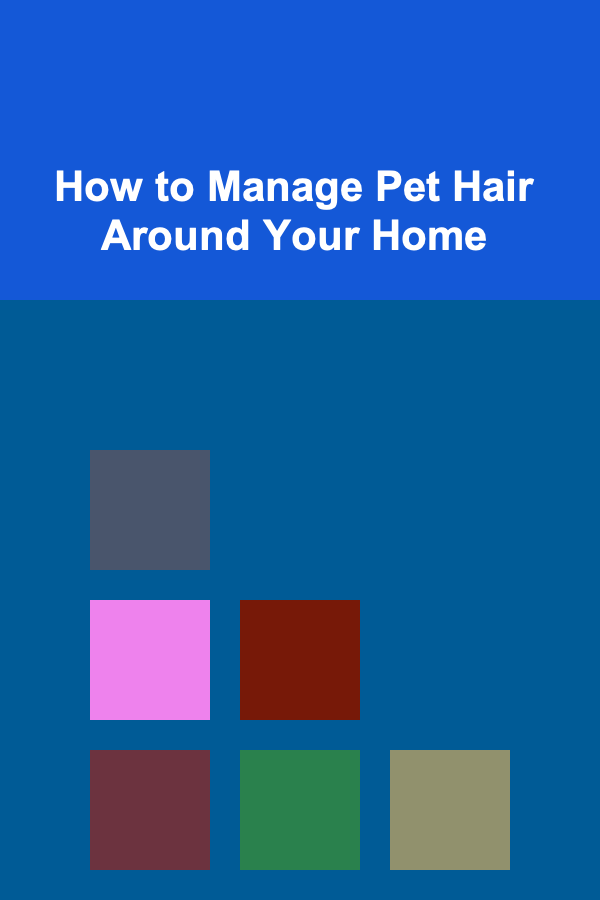
How to Manage Pet Hair Around Your Home
ebook include PDF & Audio bundle (Micro Guide)
$12.99$11.99
Limited Time Offer! Order within the next:

Pets are beloved members of many families, providing companionship, joy, and comfort. However, owning pets also comes with its share of challenges, and one of the most common challenges for pet owners is managing the constant shedding of pet hair around the home. Whether you have a dog, cat, or other furry animal, dealing with pet hair is a part of daily life that requires proactive strategies to keep your living space clean and comfortable.
Managing pet hair can feel like an ongoing battle, but with the right tools, techniques, and mindset, it is possible to minimize its impact and keep your home looking neat and tidy. This article will dive into effective methods for managing pet hair, from regular grooming and cleaning techniques to the right products that can help you stay on top of the shedding.
Understanding Pet Hair and Shedding
Before diving into management techniques, it's important to understand why pets shed hair in the first place. All mammals, including pets, shed hair as part of a natural cycle. Shedding helps animals get rid of old or damaged fur and make way for new growth. However, the amount and frequency of shedding can vary greatly depending on the breed, coat type, and environmental factors.
Types of Coats and Shedding Patterns
- Short-haired breeds: These pets tend to shed hair more frequently but in smaller amounts. Short-haired cats and dogs, such as Beagles and Dalmatians, shed year-round but typically don't produce as much visible hair as their long-haired counterparts.
- Long-haired breeds: Long-haired pets, such as Persians or Collies, shed in larger quantities and often have more noticeable hair around the house. Long-haired pets need regular grooming to prevent mats and tangles, and their shedding tends to be more seasonal, often peaking in spring and fall.
- Double-coated breeds: Some pets have double coats, meaning they have a dense undercoat covered by a longer outer coat. These breeds shed heavily during seasonal changes as they "blow" their coats. Examples of double-coated dogs include Golden Retrievers and Huskies.
- Hairless breeds: Even hairless pets, like the Sphynx cat, can produce oils and dander that may be bothersome. While they don't shed fur, they can still contribute to household mess in other ways.
Understanding your pet's shedding pattern is key to managing their hair. Some pets require more frequent grooming, while others may only need occasional maintenance.
Regular Grooming for Hair Control
One of the most effective ways to manage pet hair is by reducing shedding through regular grooming. Grooming helps remove dead hair before it can shed and scatter throughout your home. The more you groom your pet, the less likely you are to see excess hair on your furniture and floors.
Brushing Your Pet
Brushing your pet's coat regularly is one of the simplest and most effective ways to manage their shedding. Brushing helps remove loose fur, dirt, and dander, and it can even prevent mats and tangles in long-haired pets. It's important to use the right kind of brush for your pet's coat type.
- Short-haired pets: A soft-bristle brush or a grooming glove is usually sufficient for short-haired pets. These tools will help remove loose hair without irritating the skin.
- Long-haired pets: Long-haired pets, such as cats or long-haired dogs, require more specialized grooming tools. A slicker brush or a comb with wide teeth can help remove tangles and mats while lifting away loose fur.
- Double-coated pets: Double-coated pets shed heavily, especially during shedding seasons. A de-shedding tool like the Furminator can help remove undercoat hair without damaging the top coat.
Bathing Your Pet
Bathing your pet can help to control shedding by removing loose fur. However, it's important not to over-bathe your pet, as this can dry out their skin and lead to irritation. Typically, bathing your pet once a month is enough for most pets, though some may require more frequent baths depending on their activity levels and coat type.
When bathing your pet, use a gentle pet shampoo designed to reduce shedding. This can help remove loose hair and prevent it from spreading around the house.
Nail Clipping and Ear Cleaning
While not directly related to hair shedding, regular grooming tasks like nail clipping and ear cleaning can help keep your pet comfortable and reduce the amount of hair they leave around the house. Long nails can get caught in carpets or fabrics, leading to clumps of hair being pulled out. Similarly, clean ears can help prevent itching, which could lead to excessive scratching and hair loss.
Cleaning Techniques for Managing Pet Hair
No matter how much grooming you do, some pet hair will inevitably end up around your home. Fortunately, there are several techniques and tools you can use to keep your space clean and hair-free.
Vacuuming
Vacuuming is one of the most effective ways to manage pet hair. Regular vacuuming can help remove hair from carpets, rugs, upholstery, and even hard floors. However, not all vacuums are created equal, so it's essential to choose one that is designed to handle pet hair.
- Pet-specific vacuums: Many vacuum cleaners come with specialized attachments designed to lift pet hair from various surfaces. Look for models with strong suction power, rotating brushes, and HEPA filters to trap pet dander.
- Vacuum attachments: Invest in specialized attachments like a crevice tool, upholstery brush, or pet hair removal tool to clean difficult areas. These tools are perfect for getting into corners, between cushions, and along edges where pet hair can collect.
- Robot vacuums: If you're looking for a more hands-off approach, consider a robot vacuum. Many modern robot vacuums are designed to handle pet hair, and you can program them to clean your home while you're away.
- Vacuuming routine: Aim to vacuum at least once or twice a week, or more frequently if your pet sheds heavily. Areas where your pet spends the most time---such as their favorite spot on the couch or bed---should be vacuumed regularly to prevent hair buildup.
Lint Rollers and Pet Hair Removers
For quick and easy cleanup, lint rollers are an excellent tool for removing pet hair from clothing, furniture, and bedding. Simply roll the sticky surface over the area to pick up hair and debris. They are especially useful for soft surfaces like couches, chairs, and clothing.
Alternatively, there are pet-specific hair removers available, such as rubber pet hair removers or fabric brushes. These tools work by using static electricity or rubber bristles to lift pet hair off fabrics. They are great for upholstery, blankets, and cushions.
Washable Covers and Blankets
Covering your furniture with washable blankets or slipcovers can help protect it from pet hair. These covers are easy to remove and throw in the wash, making it simple to keep your furniture clean. You can also find specially designed furniture covers that are more resistant to pet hair, which can make it easier to remove hair after use.
Air Purifiers
Air purifiers equipped with HEPA filters are another useful tool for reducing pet hair and dander in your home. These devices can help remove airborne particles, including pet hair and dander, from the air. This is particularly helpful for those with allergies or in homes where pets shed heavily.
Place an air purifier in high-traffic areas, such as the living room or bedroom, to keep the air clean and reduce the amount of pet hair settling on surfaces. Make sure to clean the filter regularly to ensure maximum efficiency.
Pet-Specific Products for Hair Control
In addition to regular grooming and cleaning, there are a variety of pet-specific products designed to help control shedding. These products can be used to complement your efforts in managing pet hair around the house.
Anti-Shedding Shampoo
There are shampoos available that are designed to help reduce shedding. These shampoos contain ingredients that help promote a healthy coat and skin, reducing the amount of hair your pet sheds. Some of these shampoos are formulated to moisturize the skin, preventing dryness and excessive shedding.
Nutritional Supplements
Some pet owners find that supplementing their pet's diet with specific vitamins and minerals can help reduce shedding. Omega-3 fatty acids, for example, are known to promote a healthy coat and skin. Speak with your veterinarian about the possibility of adding supplements to your pet's diet.
De-Shedding Tools
As mentioned earlier, specialized de-shedding tools, such as the Furminator, can help remove undercoat hair before it sheds. These tools are particularly useful for pets with dense, double coats. Regular use of de-shedding tools can help minimize the amount of fur left behind in your home.
Preventing Pet Hair in the First Place
While you can never fully eliminate pet hair from your home, there are some steps you can take to reduce the amount that ends up around your house.
Creating Pet-Free Zones
One way to manage pet hair is to designate certain areas of your home as pet-free zones. This might include bedrooms, guest rooms, or dining areas. By keeping pets out of these areas, you can reduce the amount of hair that accumulates in these spaces.
Grooming Before Going Inside
If you have a pet that enjoys spending time outdoors, consider brushing them before they come inside. This can help remove excess hair that might otherwise be shed on your floors, furniture, and bedding.
Conclusion
Managing pet hair around your home is an ongoing challenge for pet owners, but it's not an impossible task. Through regular grooming, cleaning, and the use of the right products, you can reduce the amount of hair left around your house. By staying on top of your pet's shedding habits and incorporating the right tools and routines, you can keep your home clean, comfortable, and welcoming for both you and your furry companions.
Whether you're dealing with a dog that sheds heavily in the spring or a cat that leaves fur everywhere, the key to managing pet hair is consistency. The more effort you put into managing pet hair, the easier it will be to maintain a clean and pleasant living environment.

How to Build Your Part-Time Marketing Consulting Business from Scratch
Read More
How to Compare Dropshipping Suppliers to Choose the Best Fit for Your Business
Read More
How to Decorate a Small Apartment on a Budget
Read More
What Techniques Can Help You Create a Clutter-Free Home Environment?
Read More
How To Master Fingerstyle Ukulele
Read More
How to Combine Errands for Maximum Time Savings
Read MoreOther Products

How to Build Your Part-Time Marketing Consulting Business from Scratch
Read More
How to Compare Dropshipping Suppliers to Choose the Best Fit for Your Business
Read More
How to Decorate a Small Apartment on a Budget
Read More
What Techniques Can Help You Create a Clutter-Free Home Environment?
Read More
How To Master Fingerstyle Ukulele
Read More